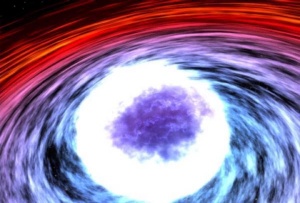May 6 2009
Research by a theoretical physicist at Indiana University shows that the crusts of neutron stars are 10 billion times stronger than steel or any other of the earth's strongest metal alloys.
 Illustration of a neutron star -- the core remains of a star once bigger than the Sun yet now small enough to fit within the Washington Beltway -- containing densely packed matter. (Credit: Image courtesy of NASA)
Illustration of a neutron star -- the core remains of a star once bigger than the Sun yet now small enough to fit within the Washington Beltway -- containing densely packed matter. (Credit: Image courtesy of NASA)
Charles Horowitz, a professor in the IU College of Arts and Sciences' Department of Physics, came to the conclusion after large-scale molecular dynamics computer simulations were conducted at Indiana University and Los Alamos National Laboratory in New Mexico.
Exhibiting extreme gravity while rotating as fast as 700 times per second, neutron stars are massive stars that collapsed once their cores ceased nuclear fusion and energy production. The only things more dense are black holes, as a teaspoonful of neutron star matter would weigh about 100 million tons.
Scientists want to understand the structure of neutron stars, in part, because surface irregularities, or mountains, in the crust could radiate gravitational waves and in turn may create ripples in space-time. Understanding how high a mountain might become before collapsing from the neutron star's gravity, or estimating the crust's breaking strain, also has implications for better understanding star quakes or magnetar giant flares.
"We modeled a small region of the neutron star crust by following the individual motions of up to 12 million particles," Horowitz said of the work conducted through IU's Nuclear Theory Center in the Office of the Vice Provost for Research. "We then calculated how the crust deforms and eventually breaks under the extreme weight of a neutron star mountain."
Performed on a large computer cluster at Los Alamos National Laboratory and built upon smaller versions created on special-purpose molecular dynamics computer hardware at IU, the simulations identified a neutron star crust that far exceeded the strength of any material known on earth.
The crust could be so strong as to be able to elicit gravitational waves that could not only limit the spin periods of some stars, but that could also be detected by high-resolution telescopes called interferometers, the modeling found.
"The maximum possible size of these mountains depends on the breaking strain of the neutron star crust," Horowitz said. "The large breaking strain that we find should support mountains on rapidly rotating neutron stars large enough to efficiently radiate gravitational waves."
Because of the intense pressure found on neutron stars, structural flaws and impurities that weaken things like rocks and steel are less likely to strain the crystals that form during the nucleosynthesis that occurs to form neutron star crust. Squeezed together by gravitational force, the crust can withstand a breaking strain 10 billion times the pressure it would take to snap steel.
Horowitz's most recent work on neutron stars was supported by a grant from the U.S. Department of Energy and through Shared University Research Grants from IBM to IU. Working with Horowitz were Don Berry, a principal systems analyst with the High Performance Applications Group in University Information Technology Services at Indiana University, and Kai Kadau at Los Alamos National Laboratory.